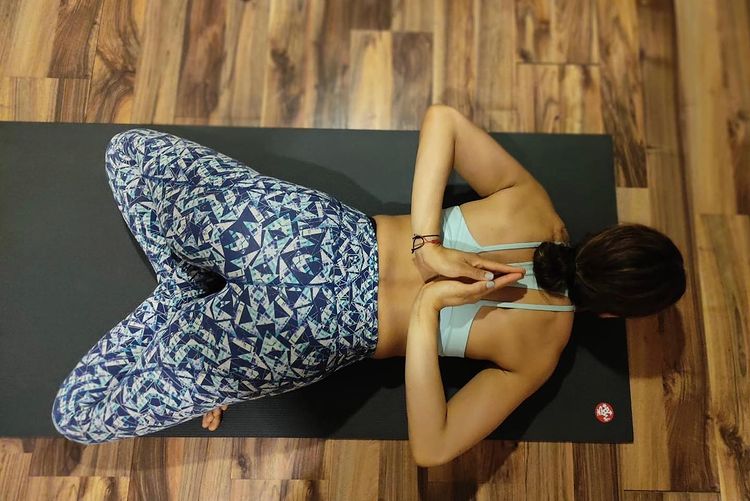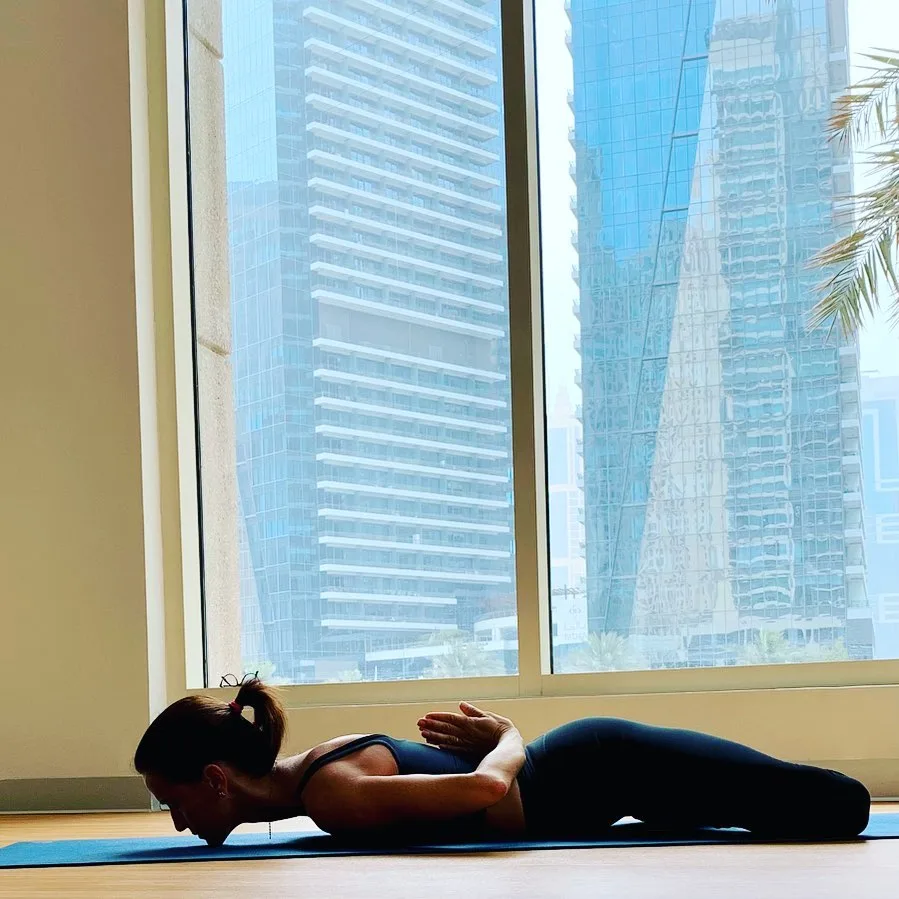Hidden Lotus Pose, also known as Gupta Padmasana, stretches and strengthens your neck, arms, shoulders, spine, and hips.
The pose is helpful for migraine and has a positive effect on your entire spine. It is especially good for a rounded back and hip dislocation.
This yoga pose makes your feet more supple and helps us to sit in Lotus Pose for a longer period of time. This pose also corrects the postural alignment of your spine.
Information
| Known as: | Hidden Lotus Pose, Gupta Padmasana |
| Sanskrit name: | गुप्त पद्मासन |
| IAST: | Gupta padmāsana |
| Pronunciation: | GUP-taa pod-MAHS-anna |
| Type: | Stretch, prone |
| Level: | Intermediate |
| Total time: | 30 to 120 seconds |
| Focus: | Spine, neck, arms, shoulders, hips |
| Drishti: | Forward; Close eye; Third eye |
| Chakra: | Vishuddha Chakra, Anahata Chakra, Swadisthana Chakra |
| Indications: | Reproductive organs, abdominal organs, heart, thyroid gland, digestive system, hypertension, diabetes, insomnia, cardiac-related issues, stress, depression, anxiety, kundalini activation |
| Counterposes: | Bandha padmasana (Bound Lotus Pose, or Closed Lotus Pose), Padmasana (Lotus Pose) |
| Preparatory poses: | Lotus Pose (Padmasana), Cow Face Pose (Gomukhasana), Baddha Konasana (Bound Angle Pose), Ardha Matsyendrasana (Half Lord of the Fishes Pose) |
| Follow-up poses: | Janusirsasana (Head-to-Knee Pose), Paschimottanasana (Seated Forward Bend Pose), Savasana (Corpse Pose) |
| Contraindications: | Cervical spine problems, hips, knees, or shoulders pain, ankles, or lower back, or rib cage injuries, abdominal surgery, sciatica, pregnant women and women during menstruation |
Meaning
Gupta Padmasana, derived from the Sanskrit name that made from three words — Gupta + Padma + Asana:
- “Gupta” = “hidden, or preserved, or guarded”
- “Padma” = “lotus”
- “Asana” = “pose or posture”
The feet and lotus position are hidden under the body in this pose, hence the name.
The Swadhisthana Chakra is stimulated in this yoga pose. The Swadhisthana Chakra (Sacral chakra) helps in developing resilience in life. Driven by pleasure, it is the driving force for the enjoyment of life through the senses. Be it hearing, taste, touch, or sight. A balanced Swadhisthana allows you to feel the world around you and within. And it is the basis of the sense of well-being.
Benefits of Hidden Lotus Pose (Gupta Padmasana)
Practicing Hidden Lotus Pose (Gupta Padmasana) comes with combined physical and mental benefits of Lotus Pose and Reverse Corpse Pose.
However, the other physical and mental benefits are listed below:
- Physical Benefits:
- Strengthens the spine, neck, arms, shoulders, and hips
- Stretches the neck, arms, shoulders, spine, and hips
- Open the chest and shoulders
- Improves the flexibility of the wrists, shoulders, ankles, knees, pelvis, and hips
- Improve the posture
- Aligned the neutral spine
- Stimulate the reproductive organs, digestive system, abdominal organs, and heart
- Enhances the function of thyroid gland
- Balance the hormones
- Better for women’s health
- Aids in activating the Kundalini
- Encourage better breathing
- Helps in conditions like high blood pressure, diabetes, insomnia, and cardiac problems
- Mental Benefits:
- Calms the mind and body
- Reduces the stress
- Relieves the anxiety
- Reduces depression
Step-by-step Hidden Lotus Pose (Gupta Padmasana)

Step-1
Sit in a Lotus Pose (Padmasana) (left foot on top of your right thigh, right foot on your left thigh, with a straight spine and neck) and take a few deep breaths. Bring awareness to the present moment and relax the tension in the body.
Step-2
Place hands on floor in front of knees, bend torso forward, lift hips and stand on knees. Make sure the knees remain in Lotus Pose (Padmasana).
Step-3
Now slowly lower the torso towards the floor till the chin, chest, and abdomen touch the floor. Make sure you don’t overstretch the body and do yoga postures according to the level of flexibility.
Step-4
Once you are comfortable in this position, bring the palms behind the back with the fingers pointing towards the head. If possible, touch the back of the head with the middle finger. Make sure the upper body remains flat on the floor. Close the eyes, take a deep breath and relax the body. Bring awareness to the heart chakra. Stay in this pose for 30 seconds to 120 seconds, or as long as you can.
Step-5
To come out of the pose, lift the upper body with the help of the arms and slowly push the torso back, until you sit on the hips. Open the legs with Lotus Pose (Padmasana) and relax the body before practicing again.
Anatomy engaging tips and techniques
The Hidden Lotus Pose (Gupta Padmasana) is an advanced yoga pose that requires a high degree of flexibility and engagement of several muscle groups in the body. The following are some anatomy engaging tips and techniques to practice the pose correctly:
- Engage your hip flexors: The hip flexors are a group of muscles that allow you to bring your knees up towards your chest. In the Hidden Lotus Pose, engaging the hip flexors is essential to bring your feet as close to your body as possible. To engage your hip flexors, draw your knees towards your chest and hold them there for a few breaths before bringing them into the lotus position.
- Lengthen your spine: Lengthening your spine is crucial in Hidden Lotus Pose, as it helps to maintain good posture and avoid compression in the lower back. To lengthen your spine, draw your shoulder blades back and down, lift your chest, and lengthen the crown of your head towards the ceiling.
- Engage your core: Engaging your core muscles, including the rectus abdominis and the obliques, can help stabilize your pelvis and prevent strain on your lower back. To engage your core, draw your navel towards your spine and engage your abdominal muscles.
- Stretch your hips: The lotus position is a deep hip opener, and stretching your hips is essential to avoid injury and improve flexibility. To stretch your hips, press the soles of your feet together and gently push your knees towards the floor. You can also use your elbows to apply gentle pressure on your thighs to deepen the stretch.
By engaging these muscle groups and using proper alignment, you can deepen your practice of the Hidden Lotus Pose, increase your flexibility, and avoid injury. Remember to approach this pose with patience and caution, and never push yourself beyond your limits.
Common mistakes
A common beginner’s mistake is to run away from this yoga pose and give up too quickly. Hidden lotus pose is an intermediate level and requires practice.
If you can’t touch the chin to the floor or clasp the hands behind the back, use props like a yoga block or yoga strap to help you achieve the correct alignment of the pose. If you are having trouble with Lotus Pose (Padmasana) you can try the Hidden Lotus Pose with One-legged Lotus Pose or Simple Cross-legged Pose.
As with any challenging pose, there are some common mistakes that practitioners can make. These mistakes can lead to discomfort, injury, or an ineffective practice. Here are some common mistakes in Hidden Lotus Pose and why and how they happen:
- Forcing the posture: Trying to force your body into the Hidden Lotus Pose before you are ready can lead to injury. This can happen if you do not have the flexibility in your hips and knees to bring your feet close to your body. It is important to be patient and allow your body to gradually open up over time with regular practice.
- Rounding the spine: When you round your spine in Hidden Lotus Pose, you put pressure on your lower back and can cause discomfort or injury. This can happen when you lean forward to reach your feet or let your shoulders collapse forward. Keep your spine long and your shoulders back and down to maintain good posture.
- Tension in the shoulders: Holding tension in your shoulders can lead to discomfort and make it harder to balance in the pose. This can happen when you are trying to hold the pose with your arms behind your back. Try to keep your shoulders relaxed and avoid tensing up.
- Neglecting to breathe: Breathing is an essential aspect of any yoga practice, and neglecting to breathe can make it harder to hold the pose and can cause tension in the body. Remember to breathe deeply and evenly throughout the pose, inhaling and exhaling through the nose.
- Pushing through pain: If you experience pain or discomfort in the pose, it is important to listen to your body and release the pose. Pushing through pain can lead to injury and make it harder to progress in your practice.
By being aware of these common mistakes and taking steps to avoid them, you can practice Hidden Lotus Pose safely and effectively. Remember to approach the pose with patience, listen to your body, and seek guidance from a qualified yoga teacher if you have any concerns or questions.
Precautions and contraindications
Practicing this yoga pose is a forward-leaning pose with the legs in Lotus Pose (Padmasana), you must keep the following precautions and contraindications in mind while practicing the Hidden Lotus Pose, which are explained below:
Injury and surgery
Sufferers of any injury to the ankles, knees, hips, shoulders, lower neck, or rib cage, or any ligament injury to any part of the body, and who have recently undergone abdominal surgery, they should avoid this pose.
Physical strength and weak body
Individuals with weak musculature, or any physical condition that may affect breathing, or general health, then away from this practice.
Cervical spine problems, sciatica, arthritis, ankle, herniated disc issues
It’s best to avoid if you have cervical spine problems, sciatica, arthritis in the knees or ankles, a weak back, herniated discs, not yet 8+ weeks since delivery, or any other condition that can disturb the body’s energy.
Senior citizens
Senior citizens should do the exercises at a slower pace, as your knees and ankles are weak.
Women
The Hidden Lotus Pose (Gupta Padmasana) is not suitable for pregnant women and women during menstruation.















